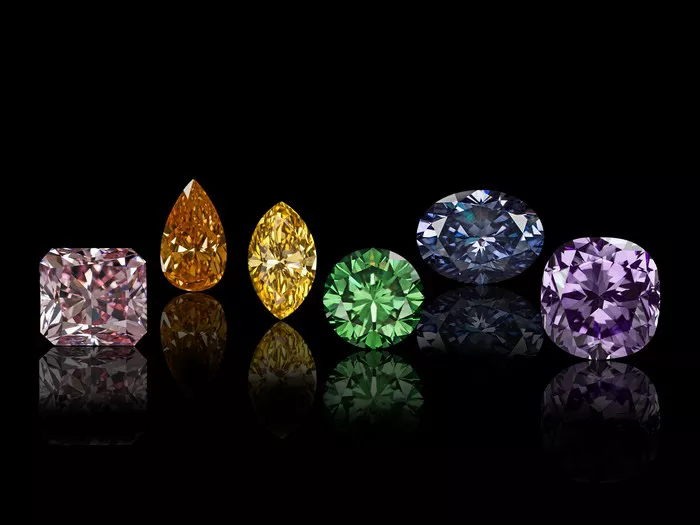Diamonds have long captivated the human imagination with their dazzling brilliance and timeless elegance. They are often celebrated for their clarity and colorlessness, but diamonds come in a spectrum of hues, each with its own unique charm. In this comprehensive exploration, we delve into the mesmerizing world of diamond colors, the science behind their shine, and how to distinguish between genuine diamonds and their imitations.
Explanation of Diamond Colors
While the popular perception of diamonds may lean towards a crystal-clear appearance, the reality is far more diverse. Diamonds can exhibit a range of colors, from the icy brilliance of white diamonds to the warm glow of yellow, the subtle sophistication of pink, and even rare shades like blue, green, or red. These colors are the result of various elemental impurities or structural defects present during the diamond’s formation process deep within the Earth’s crust.
Natural colored diamonds are prized for their rarity and unique aesthetic appeal. The intensity and purity of their color play a significant role in determining their value, with some hues commanding exorbitant prices on the market. Fancy colored diamonds, those with vibrant and distinct colors, are particularly coveted by collectors and connoisseurs for their exceptional beauty and rarity.
Diamond Color Grading
The Gemological Institute of America (GIA), the foremost authority in gemological research and education, employs a standardized grading system to assess the color of diamonds. This system, known as the D to Z scale, categorizes diamonds based on their perceived colorlessness or presence of hue. Diamonds graded D are considered colorless, while those graded Z exhibit noticeable coloration.
The color grading process involves comparing the diamond under controlled lighting conditions to a set of master stones with known colors. Gemologists evaluate the presence and intensity of any hue, as well as the overall saturation and distribution of color within the stone. The slightest variation in color can significantly impact a diamond’s grade and market value.
The Science of Shine
At the heart of a diamond’s allure lies its ability to reflect and refract light with unparalleled brilliance. When light enters a diamond, it undergoes a series of interactions with the internal facets, resulting in two distinct optical effects: brilliance and fire.
Brilliance refers to the white light that radiates from a diamond, creating the illusion of brightness and sparkle. This effect is primarily influenced by the quality of the diamond’s cut, which determines how effectively light is reflected internally and returned to the viewer’s eye. A well-cut diamond will exhibit maximum brilliance, captivating observers with its luminous glow.
Fire, on the other hand, refers to the dispersion of colored light within the diamond, manifesting as flashes of spectral colors such as red, blue, and green. This phenomenon occurs when white light is separated into its component wavelengths as it passes through the diamond’s facets. Diamonds with high levels of dispersion are prized for their vivid display of colors, adding an enchanting allure to their appearance.
Real vs. Fake Diamonds
Distinguishing between real diamonds and their synthetic or imitation counterparts can be a daunting task, but understanding their optical properties can provide valuable clues. Genuine diamonds typically exhibit a unique pattern of internal reflections known as brilliance and scintillation. When viewed under a bright light source, real diamonds will sparkle with flashes of white and gray, creating a distinct play of light within the stone.
Additionally, authentic diamonds have a high refractive index, which causes them to reflect rainbow colors onto nearby surfaces when exposed to direct sunlight or intense artificial lighting. This phenomenon, known as spectral dispersion, is a hallmark of natural diamonds and is rarely replicated in synthetic or imitation stones.
Factors Affecting Diamond Sparkle
While a diamond’s color and cut are fundamental determinants of its brilliance, other factors can influence its sparkle and overall appearance. One such factor is fluorescence, a phenomenon where certain diamonds emit a soft glow when exposed to ultraviolet light. While fluorescence can enhance the perceived whiteness of a diamond in some cases, excessive fluorescence may cause the stone to appear hazy or cloudy under certain lighting conditions.
Similarly, internal inclusions or structural imperfections known as “clouds” can detract from a diamond’s brilliance by interrupting the passage of light through the stone. Diamonds with high levels of clarity, meaning fewer visible inclusions, are prized for their exceptional transparency and brilliance.
In conclusion, the allure of diamonds lies not only in their timeless beauty but also in the intricate interplay of light and color that distinguishes each stone. From the icy brilliance of colorless diamonds to the mesmerizing hues of fancy colored gems, diamonds continue to captivate and inspire with their radiant sparkle. Understanding the nuances of diamond colors and the factors that influence their shine empowers enthusiasts and collectors to appreciate these exquisite treasures in all their splendor.

